warning Lancia Delta 2015 Owner handbook (in English)
[x] Cancel search | Manufacturer: LANCIA, Model Year: 2015, Model line: Delta, Model: Lancia Delta 2015Pages: 291, PDF Size: 6.74 MB
Page 198 of 291

196IN AN EMERGENCY
STARTING THE ENGINE
Go to a Lancia Dealership immediately if instrument pan-
el
Ywarning light remains on constantly.
JUMP STARTING fig. 1
If the battery is flat, the engine may be started using an
auxiliary battery with the same capacity or a little high-
er than the flat one.
fig. 1L0E0074m
Strictly avoid using a rapid battery charger
for jump starting: this could damage the elec-
tronic systems and the engine fuel supply and
ignition control units.
This starting procedure must be carried out
by expert personnel as incorrect manoeuvres
can cause electrical discharges of consider-
able intensity. Furthermore, battery fluid is poiso-
nous and corrosive: avoid contact with skin and
eyes. Keep naked flames away from the battery. No
smoking. Do not cause sparks.
195-232 Delta GB 1ed 03/03/14 09.14 Pagina 196
Page 205 of 291

IN AN EMERGENCY203
4
BOTTLE REPLACEMENT PROCEDURE
To replace the bottle, proceed as follows:
❍disconnect connection A - fig. 7;
❍ turn the bottle to be replaced anticlockwise and raise
it;
❍ fit the new bottle and turn it clockwise;
❍ connect connection A to the bottle and fit the trans-
parent tube B in the dedicated space.
fig. 7L0E0289m
REPLACING A WHEEL
GENERAL INSTRUCTIONS
The car may be originally fitted with a space-saver wheel
(for versions/markets, where provided).
Wheel replacement and correct use of the jack and space-
saver wheel call for some precautions as listed below.
The space-saver wheel provided (for ver-
sions/markets, where provided) is specific for
the car; do not use it on other models, or use
the space-saver wheel of other models on your car.
The space-saver wheel must only be used in the
event of emergency. Never use it for more than strict-
ly necessary and never exceed 80 km/h. On the
space-saver wheel there is an orange label, sum-
marising the main warnings regarding space-saver
wheel usage restrictions.
195-232 Delta GB 1ed 03/03/14 09.14 Pagina 203
Page 206 of 291
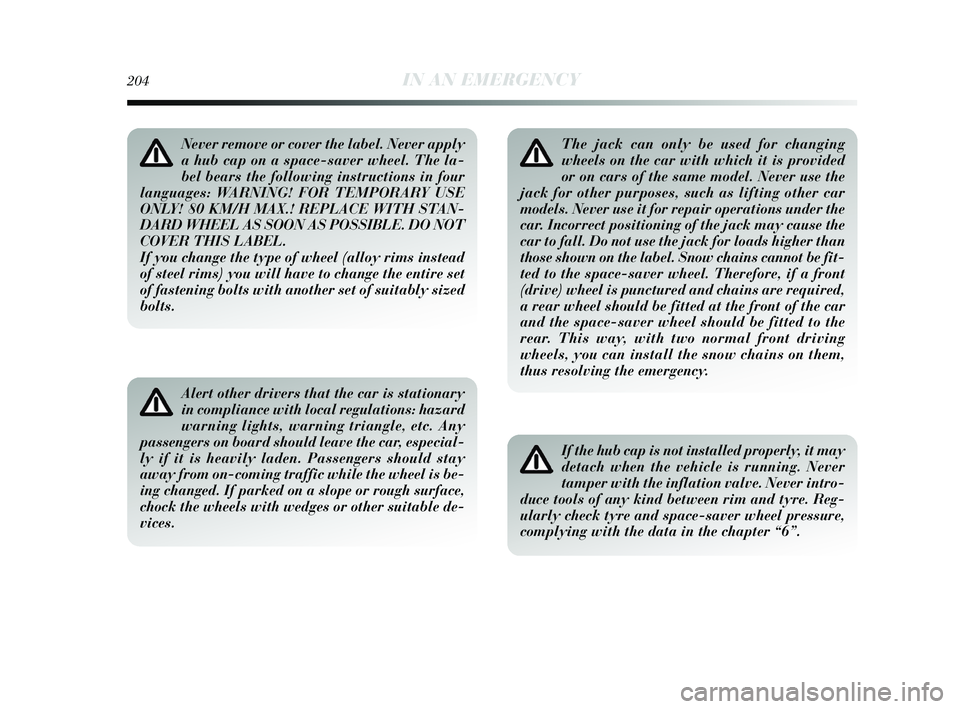
Never remove or cover the label. Never apply
a hub cap on a space-saver wheel. The la-
bel bears the following instructions in four
languages: WARNING! FOR TEMPORARY USE
ONLY! 80 KM/H MAX.! REPLACE WITH STAN-
DARD WHEEL AS SOON AS POSSIBLE. DO NOT
COVER THIS LABEL.
If you change the type of wheel (alloy rims instead
of steel rims) you will have to change the entire set
of fastening bolts with another set of suitably sized
bolts.
Alert other drivers that the car is stationary
in compliance with local regulations: hazard
warning lights, warning triangle, etc. Any
passengers on board should leave the car, especial-
ly if it is heavily laden. Passengers should stay
away from on-coming traffic while the wheel is be-
ing changed. If parked on a slope or rough surface,
chock the wheels with wedges or other suitable de-
vices.
204IN AN EMERGENCY
The jack can only be used for changing
wheels on the car with which it is provided
or on cars of the same model. Never use the
jack for other purposes, such as lifting other car
models. Never use it for repair operations under the
car. Incorrect positioning of the jack may cause the
car to fall. Do not use the jack for loads higher than
those shown on the label. Snow chains cannot be fit-
ted to the space-saver wheel. Therefore, if a front
(drive) wheel is punctured and chains are required,
a rear wheel should be fitted at the front of the car
and the space-saver wheel should be fitted to the
rear. This way, with two normal front driving
wheels, you can install the snow chains on them,
thus resolving the emergency.
If the hub cap is not installed properly, it may
detach when the vehicle is running. Never
tamper with the inflation valve. Never intro-
duce tools of any kind between rim and tyre. Reg-
ularly check tyre and space-saver wheel pressure,
complying with the data in the chapter “6”.
195-232 Delta GB 1ed 03/03/14 09.14 Pagina 204
Page 237 of 291
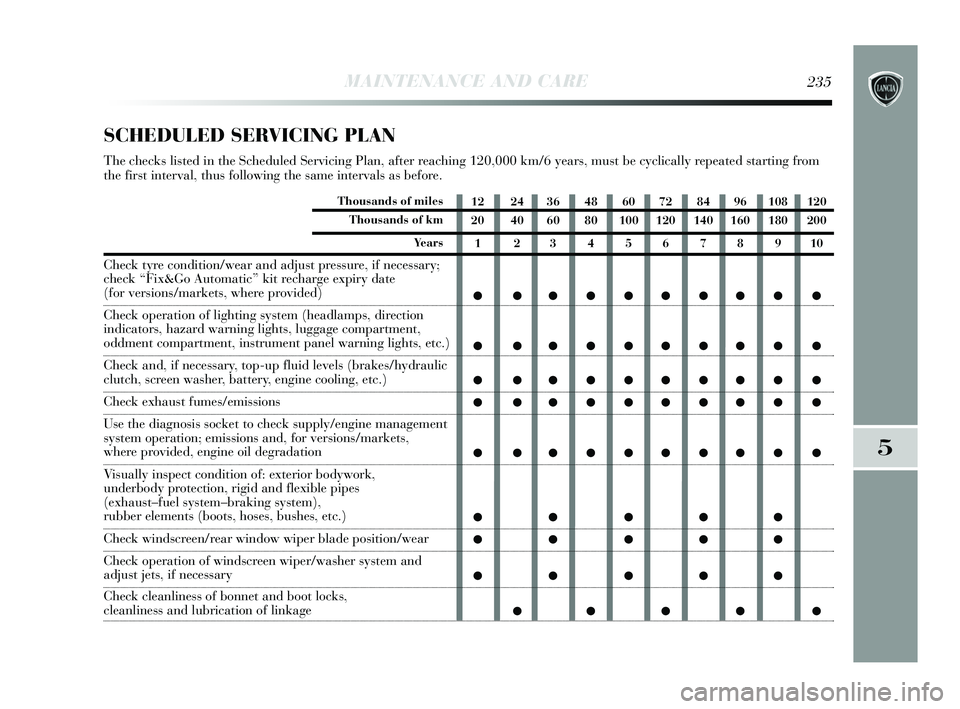
MAINTENANCE AND CARE235
5
12 24 36 48 60 72 84 96 108 120
20 40 60 80 100 120 140 160 180 2001 2345678910
● ●●●●●●●● ●
● ●●●●●●●● ●
● ●●●●●●●● ●
● ●●●●●●●● ●
● ●●●●●●●● ●
● ● ●●●
● ● ●●●
● ● ●●● ●●●● ●
SCHEDULED SERVICING PLAN
The checks listed in the Scheduled Servicing Plan, after reaching 120,000 km/6 years, must be cyclically repeated starting from
the first interval, thus following the same intervals as before.
Thousands of miles
Thousands of km
Years
Check tyre condition/wear and adjust pressure, if necessary;
check “Fix&Go Automatic” kit recharge expiry date
(for versions/markets, where provided)
Check operation of lighting system (headlamps, direction
indicators, hazard warning lights, luggage compartment,
oddment compartment, instrument panel warning lights, etc.)
Check and, if necessary, top-up fluid levels (brakes/hydraulic
clutch, screen washer, battery, engine cooling, etc.)
Check exhaust fumes/emissions
Use the diagnosis socket to check supply/engine management
system operation; emissions and, for versions/markets,
where provided, engine oil degradation
Visually inspect condition of: exterior bodywork,
underbody protection, rigid and flexible pipes
(exhaust–fuel system–braking system),
rubber elements (boots, hoses, bushes, etc.)
Check windscreen/rear window wiper blade position/wear
Check operation of windscreen wiper/washer system and
adjust jets, if necessary
Check cleanliness of bonnet and boot locks,
cleanliness and lubrication of linkage
233-256 Delta GB 1ed 03/04/14 13:27 Pagina 235
Page 238 of 291
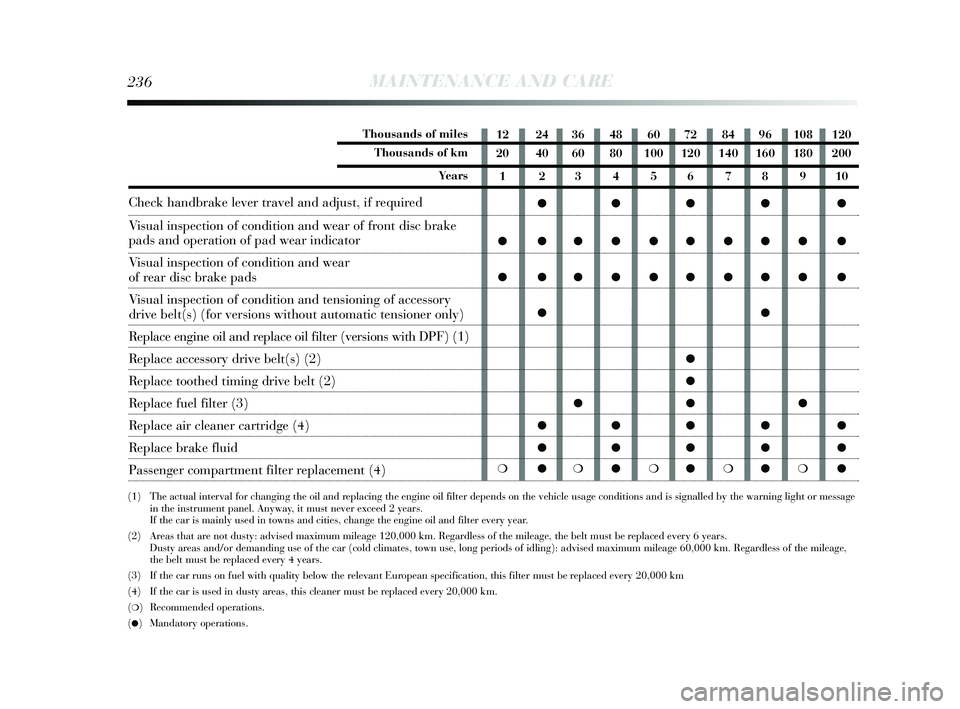
236MAINTENANCE AND CARE
12 24 36 48 60 72 84 96 108 120
20 40 60 80 100 120 140 160 180 2001 2345678910
●●●● ●
● ●●●●●●●● ●
● ●●●●●●●● ● ●●
●
●
●●●
●●●● ●
●●●● ●
❍ ●❍●❍●❍●❍ ●
(1) The actual interval for changing the oil and replacing the engine oil filter depends on the vehicle usage conditions a\
nd is signalled by the warning light or message
in the instrument panel. Anyway, it must never exceed 2 years.
If the car is mainly used in towns and cities, change the engine oil and\
filter every year.
(2) Areas that are not dusty: advised maximum mileage 120,000 km. Regardless of the mileage, the belt must be replaced every 6 y ears.
Dusty areas and/or demanding use of the car (cold climates, town use, long peri\
ods of idling): advised maximum mileage 60,000 k m. Regardless of the mileage,
the belt must be replaced every 4 years.
(3) If the car runs on fuel with quality below the relevant European specification, this filter must be replaced every 20,000 km
(4) If the car is used in dusty areas, this cleaner must be replaced every 20,000 km.
(
❍) Recommended operations.
(
●) Mandatory operations.
Thousands of miles
Thousands of km
Years
Check handbrake lever travel and adjust, if required
Visual inspection of condition and wear of front disc brake
pads and operation of pad wear indicator
Visual inspection of condition and wear
of rear disc brake pads
Visual inspection of condition and tensioning of accessory
drive belt(s) (for versions without automatic tensioner only)
Replace engine oil and replace oil filter (versions with DPF) (1)
Replace accessory drive belt(s) (2)
Replace toothed timing drive belt (2)
Replace fuel filter (3)
Replace air cleaner cartridge (4)
Replace brake fluid
Passenger compartment filter replacement (4)
233-256 Delta GB 1ed 03/04/14 13:27 Pagina 236
Page 239 of 291
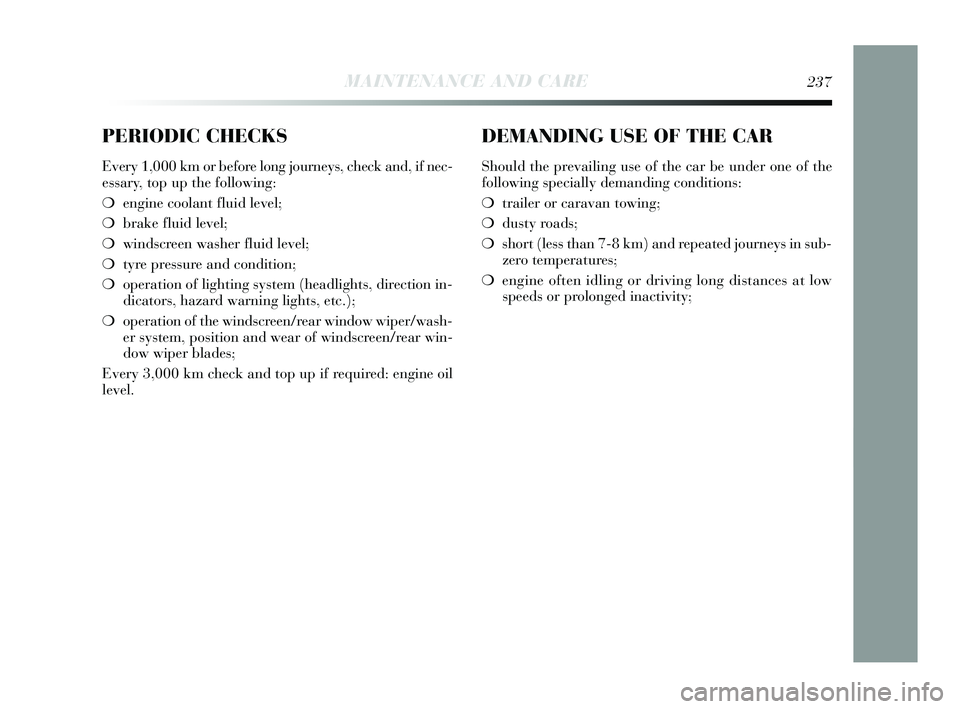
PERIODIC CHECKS
Every 1,000 km or before long journeys, check and, if nec-
essary, top up the following:
❍engine coolant fluid level;
❍ brake fluid level;
❍ windscreen washer fluid level;
❍ tyre pressure and condition;
❍ operation of lighting system (headlights, direction in-
dicators, hazard warning lights, etc.);
❍ operation of the windscreen/rear window wiper/wash-
er system, position and wear of windscreen/rear win-
dow wiper blades;
Every 3,000 km check and top up if required: engine oil
level.
DEMANDING USE OF THE CAR
Should the prevailing use of the car be under one of the
following specially demanding conditions:
❍ trailer or caravan towing;
❍ dusty roads;
❍ short (less than 7-8 km) and repeated journeys in sub-
zero temperatures;
❍ engine often idling or driving long distances at low
speeds or prolonged inactivity;
MAINTENANCE AND CARE237
233-256 Delta GB 1ed 03/04/14 13:27 Pagina 237
Page 246 of 291
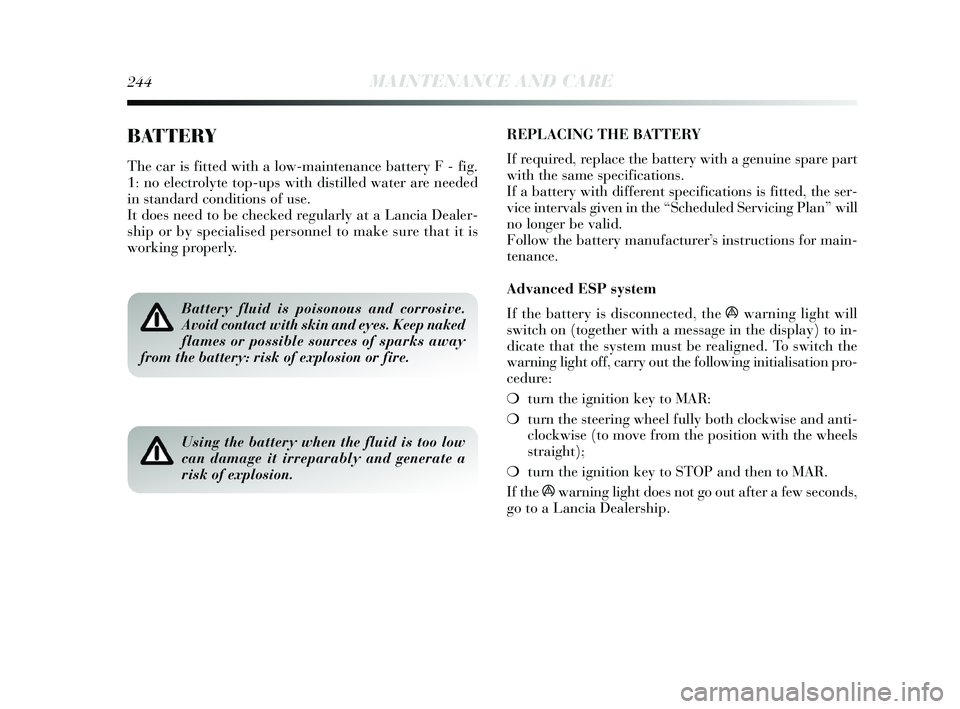
REPLACING THE BATTERY
If required, replace the battery with a genuine spare part
with the same specifications.
If a battery with different specifications is fitted, the ser-
vice intervals given in the “Scheduled Servicing Plan” will
no longer be valid.
Follow the battery manufacturer’s instructions for main-
tenance.
Advanced ESP system
If the battery is disconnected, the áwarning light will
switch on (together with a message in the display) to in-
dicate that the system must be realigned. To switch the
warning light off, carry out the following initialisation pro-
cedure:
❍ turn the ignition key to MAR:
❍ turn the steering wheel fully both clockwise and anti-
clockwise (to move from the position with the wheels
straight);
❍ turn the ignition key to STOP and then to MAR.
If the á warning light does not go out after a few seconds,
go to a Lancia Dealership.
244
MAINTENANCE AND CARE
Battery fluid is poisonous and corrosive.
Avoid contact with skin and eyes. Keep naked
flames or possible sources of sparks away
from the battery: risk of explosion or fire.
Using the battery when the fluid is too low
can damage it irreparably and generate a
risk of explosion.
BATTERY
The car is fitted with a low-maintenance battery F - fig.
1: no electrolyte top-ups with distilled water are needed
in standard conditions of use.
It does need to be checked regularly at a Lancia Dealer-
ship or by specialised personnel to make sure that it is
working properly.
233-256 Delta GB 1ed 03/04/14 13:27 Pagina 244
Page 248 of 291

246MAINTENANCE AND CARE
USEFUL ADVICE FOR EXTENDING THE LIFE OF
YOUR BATTERY
To avoid draining your battery and make it last longer,
observe the following instructions:
❍when you park the car, ensure the doors, tailgate and
bonnet are closed properly, to prevent any light from
remaining on inside the passenger compartment;
❍ turn off the internal roof lights, although the car does
have an automatic system for switching off internal
lights;
❍ do not leave devices (e.g. car radio, hazard warning
lights, etc.) switched on for a long time when the en-
gine is not running;
❍ before performing any operation on the electrical sys-
tem, disconnect the negative battery cable;
❍ battery terminals should always be perfectly tightened.
IMPORTANT If the charge level remains under 50% for
a long time, the battery is damaged by sulphation, re-
ducing its capacity and efficiency at start-up. The battery will also be more at risk of freezing (this can
happen as early as –10°C). In case of prolonged idling, re-
fer to the “Car inactivity” paragraph, in chapter “3”.
If, after purchasing your car, you decide to install electri-
cal accessories which require a permanent electric power
supply (alarm, etc.) or accessories which have a serious
impact on the electrical balance, contact a Lancia Deal-
ership: their qualified personnel will suggest the most suit-
able Lancia Lineaccessori devices and assess the overall
electric consumption, checking whether the car’s electri-
cal system can cope or whether a more powerful battery
is required.
Since some of these devices continue to consume electric-
ity even when the engine is off, they gradually run down
the battery.
233-256 Delta GB 1ed 03/04/14 13:28 Pagina 246
Page 286 of 291

284LIST OF CONTENTS
Engine codes/Bodywork versions ................ 260
Engine compartment (washing) ............................. 255
Engine.................................... 261
EOBD (system )....................... 124
External lights ........................ 67
Fitting the “Universal” child
restraint system .................... 163
Fix&Go Automatic (kit)..........198
Flashing ................................. 69
Fluids and lubr icants.............. 273
Fog lights......................... 68-79
- bulb replacement................ 217
Follow Me Home (device) ....... 70
Front headlights (cleaning) ..... 255
Front roof lights (bulb replacement) ............... 219
Front/rear armrest ........... 81-83 Fuel cap ................................. 151
Fuel consumpt
ion ................... 275
Fuel cut-off ............................ 80
Fuel supply system ................. 262
Fuses (replacement)................ 223
Gear Shift Indicator (GSI) ..... 28
Gearbox (use) ......................... 188
Glove compartment light (bulb replacem ent) ...............222
Glove compartment ................ 84
Handbrake............................. 187
Hazard warning lights ............ 78
Head restraints ....................... 55
Headlights .............................. 105
Hill Holder (syst em) ..............118
Identification data .................. 258
Ignition dev ice ........................ 51
Display .................................. 26
Door locking ........................... 89
Doors
..................................... 89
– child safety lock .................. 90
– passenger side front door and rear door emergency locking
device ................................... 91
Driving Advisor (syst em) ........ 110
Driving Advisor ..................... . 110
DRL (Daytime Running Lights) .... 67
DST (Dynamic Steering Torque) ... 107
Dualdrive (electric power steering system ) ............. 77-125Electric windows .................... 91
End of veh icle life................... 277
281-288 Delta GB 1ed 03/03/14 09.32 Pagina 284